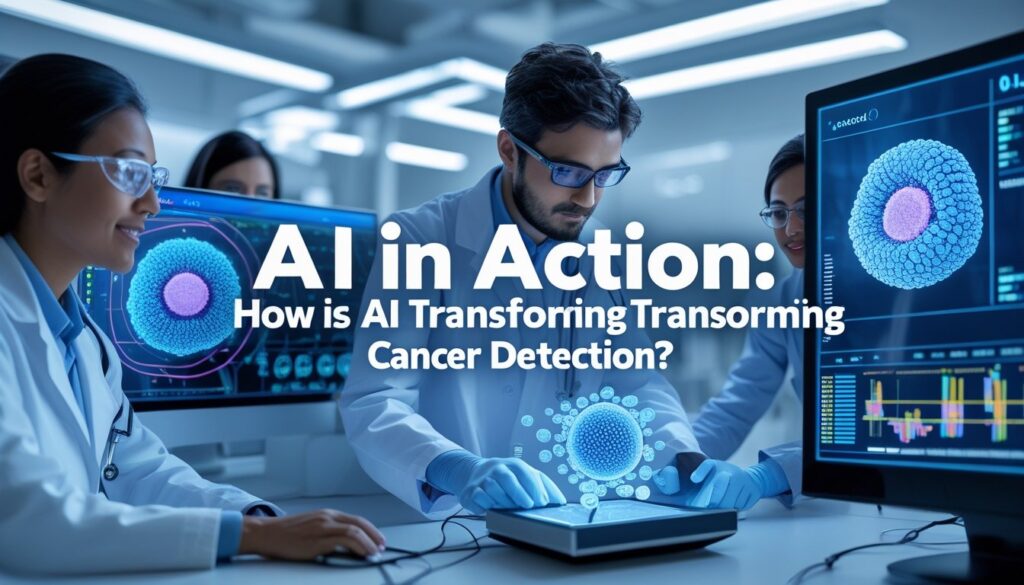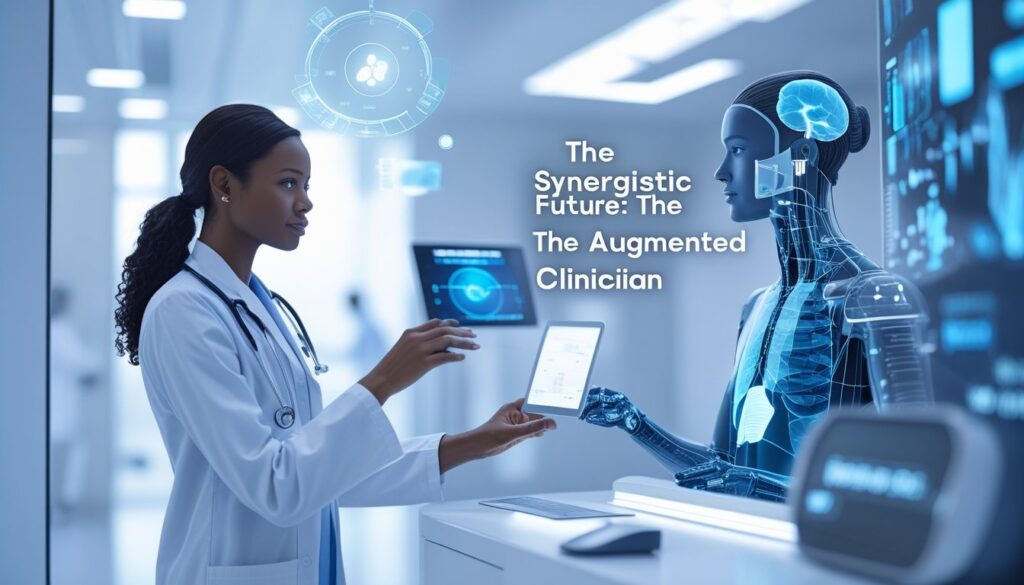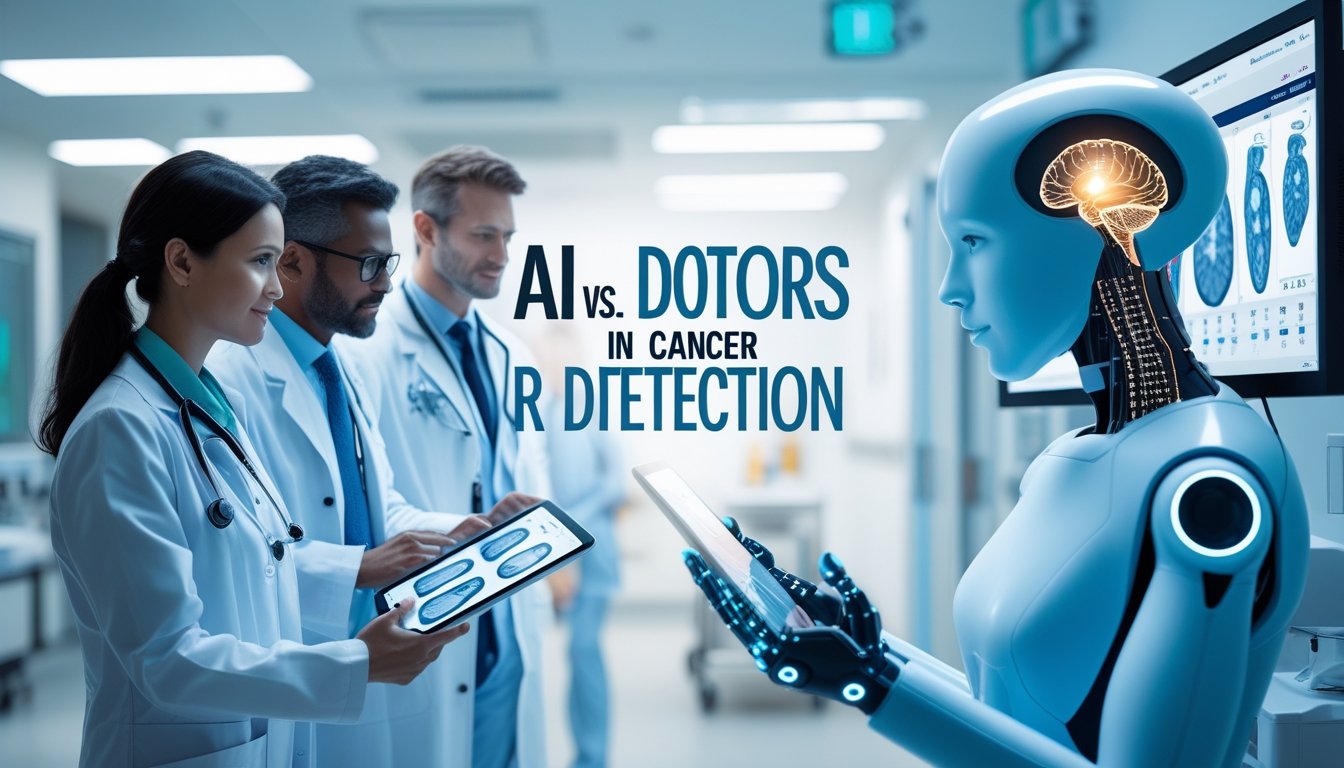AI vs. Doctors in Cancer Detection: Explore the revolution in oncology. This in-depth 7000-word analysis compares AI’s speed and accuracy with doctors’ clinical intuition, arguing for a collaborative future, not a replacement. Learn about deep learning, radiomics, early trials, and the human touch in medicine.AI vs. Doctors

The New Contender in the Ring
The fight against cancer is one of humanity’s most profound and enduring challenges. For centuries, the primary warrior in this battle has been the physician—armed with knowledge, experience, and a deeply human instinct for care. The diagnosis of cancer, a pivotal moment that alters lives, has traditionally rested on the trained eyes of these specialists: radiologists scrutinizing medical images, pathologists analyzing tissue slides, and oncologists interpreting complex clinical data.AI vs. Doctors
But a new, powerful force is entering the arena: Artificial Intelligence (AI). No longer a sci-fi trope, AI is rapidly moving from research labs into real-world clinical settings. Headlines tout its superhuman accuracy in detecting cancers from mammograms, CT scans, and MRIs. This has sparked a compelling, and often sensational, debate: Will AI replace doctors?AI vs. Doctors
The short answer is no. The more nuanced and accurate answer is that the future of oncology lies not in a battle for supremacy, but in a powerful, synergistic partnership. This article will delve deep into the world of AI in cancer detection, moving beyond the hype to provide a comprehensive analysis. We will explore how AI works, objectively compare its capabilities with those of human physicians, examine groundbreaking case studies, and ultimately paint a picture of a future where AI augments human expertise, leading to earlier diagnoses, fewer errors, and more personalized, effective patient care.AI vs. Doctors
Understanding the Players: What is AI and Machine Learning?
To understand the conversation, we must first define the terms. “Artificial Intelligence” is a broad umbrella term for machines or software that exhibit human-like intelligence.AI vs. Doctors
- Artificial Intelligence (AI): The overarching science of creating intelligent machines.
- Machine Learning (ML): A subset of AI that enables computers to learn and improve from experience without being explicitly programmed for every task. Instead of following rigid rules, ML algorithms identify patterns in data.
- Deep Learning (DL): A further subset of ML, inspired by the structure and function of the human brain, known as artificial neural networks. These are multi-layered (hence “deep”) networks that can learn incredibly complex patterns from vast amounts of data. This is the technology powering most of the recent breakthroughs in medical AI.
The Engine of Discovery: How Deep Learning Neural Networks Work
Imagine teaching a child what a cat is by showing them thousands of pictures of cats. The child’s brain begins to identify common features—whiskers, pointy ears, fur. A deep learning network does the same.AI vs. Doctors
- Input Layer: The network is fed a massive dataset of, for example, mammogram images. Each image is labeled: “cancer” or “no cancer.”
- Hidden Layers: As the image data passes through the network’s many layers, each layer extracts progressively complex features.
- The first layer might identify simple edges and gradients.
- The next layer combines these edges to form shapes.
- Deeper layers might recognize complex patterns like spiculated masses or microcalcifications—the hallmarks of certain breast cancers.
- Output Layer: The network produces a probability score: “98% likelihood of malignancy.”
- Backpropagation: If the network is wrong, the error is sent backward through the layers, and the connections (weights) between artificial neurons are adjusted. This process is repeated millions of times.
Through this iterative training, the AI model becomes exceptionally proficient at detecting the subtle patterns that indicate cancer, often patterns that are imperceptible to the human eye.AI vs. Doctors
The Critical Role of Data
The performance of an AI model is directly proportional to the quality, quantity, and diversity of the data it’s trained on. “Garbage in, garbage out” is a fundamental rule. A model trained only on data from one demographic may perform poorly on others, a significant issue we will explore in the ethics section.AI vs. Doctors
The Human Expert: The Doctor’s Role in Cancer Detection
Before we can compare, we must appreciate the immense skill and multifaceted role of the physician.
The Art and Science of Radiology
A radiologist does more than just “look at pictures.” They are physicians who interpret medical images in the context of a patient’s clinical history, symptoms, and laboratory findings. Their expertise involves:AI vs. Doctors
- Pattern Recognition: Identifying abnormalities based on years of training.
- Synthesis: Correlating findings from different imaging modalities (e.g., comparing a mammogram with an ultrasound).
- Probabilistic Reasoning: Weaving the likelihood of disease based on patient age, family history, and other risk factors.
- Communication: Discussing findings with referring physicians and, at times, directly with patients.
The Definitive Diagnosis: The Pathologist’s Microscope
Pathologists provide the definitive cancer diagnosis. They analyze tissue samples (biopsies) under a microscope to determine the cell type, grade, and stage of a cancer. This is a painstaking process that requires discerning minute cellular and architectural details. A pathologist might examine hundreds of slides in a day, a task that is both mentally and visually fatiguing.AI vs. Doctors
The Clinical Context: Synthesizing Information Beyond the Image
This is the doctor’s greatest strength. A doctor doesn’t just see a nodule on a CT scan; they see a patient. They integrate the scan with the fact that the patient is a 65-year-old smoker with a recent cough and weight loss. This holistic synthesis is something AI, in its current form, cannot replicate. It lacks the “world model” to understand the full narrative of a human life.AI vs. Doctors
Inherent Challenges: Fatigue, Bias, and the Human Factor
Human experts are not infallible. Inter-observer variability (different doctors interpreting the same image differently) and intra-observer variability (the same doctor interpreting an image differently at another time) are well-documented issues. Factors like fatigue, cognitive biases (e.g., satisfaction of search—stopping after finding one abnormality), and high workload volumes can lead to missed diagnoses or false positives.AI vs. Doctors
AI in Action: How is AI Transforming Cancer Detection?

AI is being applied across the entire spectrum of oncology. Here are the key areas:
Radiology: Enhanced Imaging Analysis
- Mammography: AI algorithms are now FDA-approved to help radiologists screen for breast cancer. They can flag suspicious areas, prioritize urgent cases, and have been shown to reduce false negatives, particularly in women with dense breast tissue where cancers are harder to spot.
- Chest CT for Lung Cancer: Low-dose CT screening for high-risk smokers is proven to save lives, but it generates a massive number of images per patient. AI excels at automatically detecting and measuring pulmonary nodules, tracking their growth over time with sub-millimeter precision.
- Brain MRI: AI can help identify brain tumors, segment their boundaries for surgical planning, and even differentiate between tumor types based on imaging characteristics.
Pathology: Digital Pathology and Whole-Slide Imaging
The field is undergoing a digital transformation. Instead of glass slides, pathologists can now view high-resolution digital scans on a computer monitor. AI algorithms can analyze these entire slides in seconds, quantifying the number of dividing cells (mitotic count), assessing tumor-infiltrating lymphocytes (a biomarker for immunotherapy response), or even identifying specific genetic mutations from the tissue morphology alone.AI vs. Doctors
Genomics: Decoding the Cancer Genome
Cancer is a disease of the genome. AI algorithms can sift through terabytes of genomic data from a tumor’s DNA to identify driver mutations, predict which therapies will be most effective, and forecast the risk of recurrence. This is the cornerstone of precision oncology.
Dermatology: AI-Powered Skin Cancer Screening
Consumer apps and clinical tools use AI to analyze images of skin lesions. Trained on hundreds of thousands of images of melanomas, nevi, and other skin conditions, these tools can provide a rapid assessment of malignancy risk, acting as a decision-support tool for dermatologists.AI vs. Doctors
The Rise of Radiomics: Extracting Invisible Data
This is a revolutionary application. Radiomics uses AI to extract hundreds of quantitative features from medical images—features like texture, shape, and intensity heterogeneity that are invisible to the human eye. These “radiomic signatures” can predict a tumor’s aggressiveness, its genetic profile, and its response to treatment, effectively turning a standard CT or MRI scan into a non-invasive biopsy.AI vs. Doctors
Head-to-Head: The Objective Comparison (AI vs. Doctors)
Let’s break down the competition across key dimensions.
| Metric | AI’s Advantage | Doctor’s Advantage | The Verdict |
|---|---|---|---|
| Accuracy & Sensitivity | Superhuman in narrow tasks. In controlled studies, AI often matches or exceeds human experts in specific detection tasks (e.g., spotting lung nodules). It has no lapses in attention and can achieve near-perfect recall. | Highly accurate but variable. A well-rested, specialized expert is exceptionally accurate. However, performance can dip due to fatigue, workload, and the inherent challenges of visual search. | A Tie, with Nuance. AI may have a slight edge in pure detection sensitivity, but the doctor’s understanding of clinical context prevents irrelevant “false positives” that an AI might flag. |
| Speed & Scalability | Overwhelming advantage. An AI can analyze a CT scan in seconds and a whole-slide pathology image in minutes, 24/7 without breaks. It can process thousands of studies per day. | Limited by human biology. A radiologist may take 10-15 minutes to read a complex CT scan. There is a global shortage of specialists, creating backlogs. | Clear Win for AI. This is AI’s most undeniable strength, offering a solution to workforce shortages and rising screening demands. |
| Consistency | Perfect. The same algorithm, given the same input, will produce the same output every single time. It is immune to fatigue, mood, or cognitive bias. | Variable. Subject to inter- and intra-observer variability. A finding seen as borderline by one radiologist may be called benign by another. | Clear Win for AI. AI provides a stable, reproducible baseline for measurement and diagnosis. |
| Clinical Context | Nonexistent. AI sees pixels, not people. It has no understanding of the patient’s pain, family history, lab results, or overall story. It operates in a vacuum. | The Core of Medical Practice. This synthesis of disparate data points is the essence of clinical judgment. It’s what separates a relevant finding from an incidentaloma. | Overwhelming Win for Doctors. This is the fundamental reason AI will not replace physicians. |
| Empathy & Communication | Zero. AI has no consciousness, no empathy, and cannot deliver a cancer diagnosis with compassion, hope, or understanding. | Fundamental. The patient-doctor relationship is built on trust and empathy. Delivering difficult news, discussing treatment options, and providing support are irreplaceable human acts. | Overwhelming Win for Doctors. |
Case Studies: Proof in the Pipeline
Google Health’s Mammography AI (2020): A landmark study published in Nature showed that an AI model developed by Google Health reduced false positives by 5.7% (US data) and false negatives by 9.4% compared to human radiologists. In a separate reader study, the AI system outperformed all six radiologists in the study. Crucially, the research highlighted that the AI and humans had different strengths and weaknesses, suggesting a combined approach would be best.AI vs. Doctors
AI in Lung Cancer Screening: The FDA-approved “AI-RAD Companion” from Siemens and other similar tools are now used in clinics. They automatically detect, segment, and characterize lung nodules on CT scans, providing measurements and growth comparisons. This not only speeds up the radiologist’s workflow but also ensures no small nodule is overlooked, facilitating earlier intervention.AI vs. Doctors
AI in Prostate Cancer: Diagnosing prostate cancer from biopsy samples is challenging, with significant variability among pathologists. An AI system developed at the University of Pittsburgh achieved an Area Under the Curve (AUC) of 0.99 (near perfect) for detecting cancer on biopsy slides. More importantly, it can also predict tumor aggressiveness, potentially helping to avoid unnecessary treatments for slow-growing cancers.AI vs. Doctors
The Synergistic Future: The Augmented Clinician

The evidence points not to replacement, but to augmentation. The future oncologist will be a “director” of a team that includes AI as a core member.AI vs. Doctors
- The Workflow Integrator: AI will act as a super-powered assistant. It will pre-read all scans, flag the most critical cases for immediate review, measure tumors automatically, and populate reports with quantitative data. This frees the physician to focus on complex cases and patient communication.
- Prioritization and Triage: In a busy emergency room, an AI could instantly identify a brain bleed on a CT scan and push it to the top of the radiologist’s worklist, saving critical minutes.
- Quantitative Biomarkers: Instead of saying “the tumor looks a bit more heterogeneous,” the radiologist can say, “the AI-calculated heterogeneity index has increased by 30%, suggesting emerging treatment resistance.” This enables truly precision medicine.
- Democratizing Expertise: An AI model trained at a top cancer center can be deployed in a rural clinic, providing every patient with access to a level of diagnostic expertise previously unavailable. This has the potential to reduce global health disparities in cancer care.
The Hurdles: Challenges and Ethical Considerations
The path forward is not without significant obstacles.AI vs. Doctors
- Data Privacy and Security: Training AI requires vast amounts of patient data. Ensuring this data is anonymized, secure, and used with patient consent is paramount.
- The “Black Box” Problem: Many complex AI models are inscrutable. We can see the input (the image) and the output (the diagnosis), but the precise reasoning path inside the “black box” is unclear. For a physician to trust a decision, they need to understand the “why.”
- Algorithmic Bias: If an AI is trained predominantly on data from white male patients, it may perform poorly when diagnosing women or people of color. A famous example is an algorithm that failed to accurately detect skin cancer on darker skin tones because it was trained mostly on light-skinned images. Vigilant curation of diverse training datasets is essential to prevent perpetuating healthcare disparities.AI vs. Doctors
- Regulatory Hurdles: The FDA and other global bodies are developing new frameworks to regulate AI-based SaMD (Software as a Medical Device). This is a complex process, as unlike a static device, AI models can “learn” and evolve over time.
- Liability and Accountability: If an AI misses a cancer, who is liable? The hospital that deployed it, the developer who created it, or the radiologist who ultimately signed off on the report? Clear legal and professional guidelines are still being established.
Partners, Not Rivals

The narrative of “AI vs. Doctors” is a compelling but ultimately misleading dichotomy. It frames the future as a zero-sum game when, in reality, it is a collaborative evolution. AI is not the usurper of the physician’s role; it is the most powerful tool ever created to augment it.AI vs. Doctors
The ideal future of cancer detection is not a room with a machine giving cold, automated diagnoses. It is a clinic where a physician, empowered by AI insights, has more time to spend with a patient. The AI has handled the tedious quantification, prioritized the day’s workload, and highlighted the most critical findings with superhuman consistency. The doctor, in turn, brings their irreplaceable clinical judgment, wisdom, and compassion to interpret this data within the full context of the patient’s life.AI vs. Doctors
The goal is not to create a healthcare system run by algorithms, but to use algorithms to create a healthcare system where every patient benefits from the combined, synergistic power of human and artificial intelligence. In the enduring fight against cancer, we need every weapon we can get. AI is not a replacement for the warrior; it is a sharper, faster, and more precise sword.AI vs. Doctors

